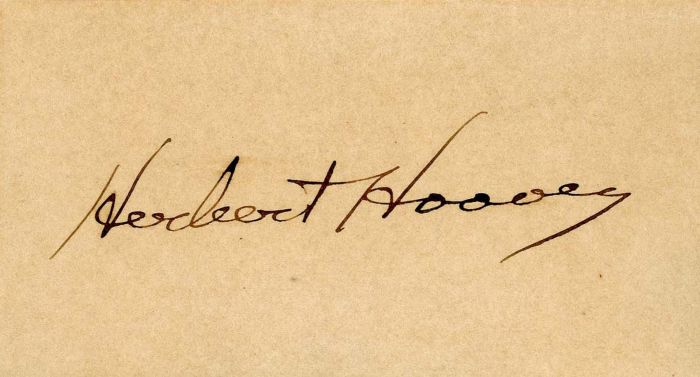Autographed Card signed by Herbert Hoover
Inv# AU1414
Autographed card signed by Herbert Hoover. Card measures 3 3/4" x 2".

Herbert Clark Hoover (August 10, 1874 – October 20, 1964) was the 31st President of the United States (1929–1933). Hoover entered Stanford University in 1891, the first year of the new California college. None of the first students were required to pay tuition. Hoover claimed to be the first student ever at Stanford, by virtue of having been the first person in the first class to sleep in the dormitory. While at the university he was the student manager of both the baseball and football teams, and was a part of the inaugural Big Game versus rival California (Stanford won). In one game in 1894, as manager of the baseball team, Hoover found the receipts were short. He went after the person who had failed to pay the 25¢, former President Benjamin Harrison. Later in life, Hoover called his encounter with Harrison, "his first time with greatness". Hoover graduated in 1895 with a degree in geology.
He was a professional mining engineer and went to Australia in 1897 as an employee of Bewick, Moreing & Co., a London-based mining company. He served as a geologist and mining engineer while searching the Western Australian goldfields for investments. Hoover was made a partner in Bewick, Moreing & Co. in 1901 and assumed responsibility for various Australian operations.
Hoover married his Stanford sweetheart, Lou Henry, in 1899 and had two sons. In August–September 1905, Hoover came up with a technological innovation. When visiting the mines at Broken Hill, New South Wales, he noticed considerable zinc in the Broken Hill lead-silver ore, which could not be recovered and was lost as tailings. Hoover devised a practical and profitable method to use the then-new froth flotation process to treat these tailings and recover the zinc. With William Baillieu and others, he founded the Zinc Corporation (later, following various mergers, a part of Rio Tinto Group).
When World War I began in August 1914, he helped organize the return of 120,000 Americans from Europe: tourists, students, executives, etc. Hoover led 500 volunteers in the distribution of food, clothing, steamship tickets, and cash. "I did not realize it at the moment, but on August 3, 1914, my career was over forever. I was on the slippery road of public life." Hoover liked to say that the difference between dictatorship and democracy was simple: dictators organize from the top down, democracies from the bottom up.
As the United States Secretary of Commerce in the 1920s under Presidents Warren G. Harding and Calvin Coolidge, he promoted government intervention under the rubric "economic modernization". In the presidential election of 1928, Hoover easily won the Republican nomination, despite having no previous elected office experience. To date, Hoover is the last cabinet secretary to be directly elected President of the United States, as well as one of only two Presidents (along with William Howard Taft) to have been elected President without electoral experience or high military rank. America was prosperous and optimistic at the time, leading to a landslide victory for Hoover over Democrat Al Smith.
Hoover deeply believed in the Efficiency Movement, which held that government and the economy were riddled with inefficiency and waste, and could be improved by experts who could identify the problems and solve them. When the Wall Street Crash of 1929 struck less than eight months after he took office, Hoover tried to combat the ensuing Great Depression with volunteer efforts, none of which produced economic recovery during his term. The consensus among historians is that Hoover's defeat in the 1932 election was caused primarily by failure to end the downward economic spiral. As a result of these factors, Hoover is ranked poorly among former US Presidents.









Ebay ID: labarre_galleries